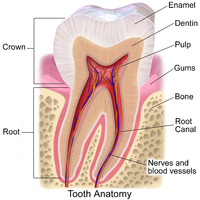
Photo from wikipedia
ABSTRACT Introduction Over the last two decades, an increasing body of research suggests that well-designed biomaterials can attract resident stem cells to injured areas and control their behaviors and activities… Click to show full abstract
ABSTRACT Introduction Over the last two decades, an increasing body of research suggests that well-designed biomaterials can attract resident stem cells to injured areas and control their behaviors and activities to encourage tissue regeneration. Fabricated biomaterials can enhance cell recruitment, multiplication, and transformation while also acting as a delivery system for targeted cells. These capabilities might play a role in their ability to promote tooth regeneration. Areas covered This review aims to introduce the various materials used in endodontics. The potential of biomaterial-based approaches involved in cell homing for endodontics is also discussed. Expert opinion Applying the cell homing technique in restorative dentistry can affect various aspects of healthcare, industry, economy, and science. Biomaterial scaffolds can be used to encapsulate cells or for structural replacements. Also, both cell transplantation and cell homing are legitimate scientific procedures in endodontic therapy. Although the suggested biomaterials and procedures may hold promise for future dental pulp tissue regeneration, tooth structure’s complexity and multicellular interconnections lead to significant problems that need to be overcome before any clinical trial.
Journal Title: Expert Opinion on Biological Therapy
Year Published: 2022
Link to full text (if available)
Share on Social Media: Sign Up to like & get
recommendations!